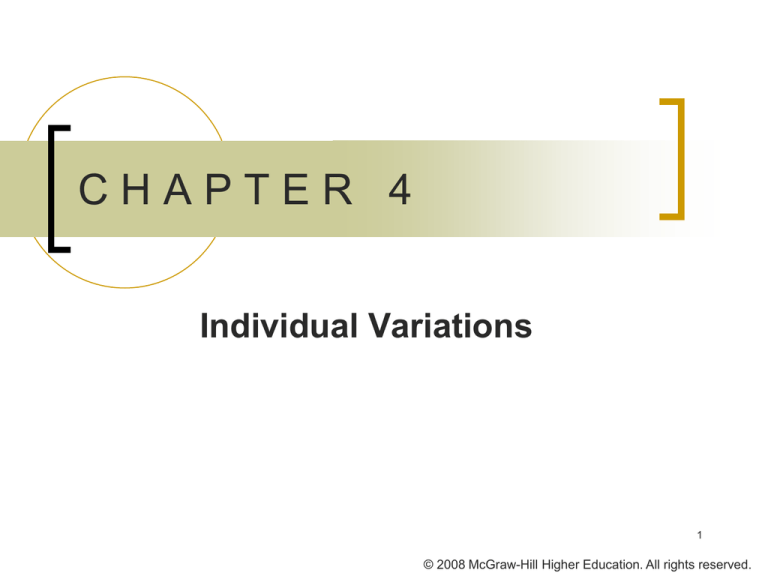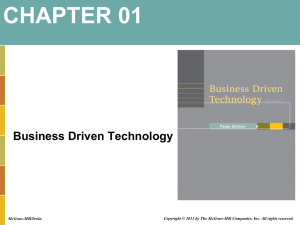
CHAPTER 4
Individual Variations
1
© 2008 McGraw-Hill Higher Education. All rights reserved.
Individual Variations
Intelligence
Individual
Intelligence Tests
Individual Tests
Versus
Group Tests
Controversies and
Issues in
Intelligence
Theories of
Multiple
Intelligence
© 2008 McGraw-Hill Higher Education. All rights reserved.
What is “Smart”?
When someone is described as
“smart,” what does that mean? What
behaviors, skills, or competencies
make someone smart? Come up with
a list of words that describe smart.
Come up with a way to assess your
definition of “smart”
© 2008 McGraw-Hill Higher Education. All rights reserved.
Binet Intelligence Tests
Mental Age
Intelligence
Quotient (IQ)
Normal
Distribution
An individual’s level of mental
development relative to others
MentalAge
IQ =
100
Chronological Age
A symmetrical distribution
Majority of the scores fall in the
middle
Few scores in the extremes
© 2008 McGraw-Hill Higher Education. All rights reserved.
The Normal Curve
© 2008 McGraw-Hill Higher Education. All rights reserved.
The Wechsler Intelligence Scales
Age-related versions provide an overall IQ and
verbal and performance IQs.
WPPSI-III Wechsler Preschool and Primary
Scale of Intelligence-Revised.
Ages 4 to 6 ½.
WISC-IV
Wechsler Intelligence Scale for
Children-Version IV. Ages 6 to 16.
WAIS-IV
Wechsler Adult Intelligence ScaleVersion IV
© 2008 McGraw-Hill Higher Education. All rights reserved.
Group Intelligence Tests
Advantage
More convenient and economical
Disadvantages
Examiner cannot:
establish rapport
determine student’s level of anxiety
Student:
might not understand instructions
might be distracted by other students
© 2008 McGraw-Hill Higher Education. All rights reserved.
Early Theories of Multiple Intelligence
Spearman (1927): People have both
general intelligence (g) and specific types
of intelligence (s).
Thurston (1938): People have seven
specific intellectual abilities: verbal
comprehension, associative memory, word
fluency, reasoning, number ability, spatial
visualization, and perceptual speed.
© 2008 McGraw-Hill Higher Education. All rights reserved.
Sternberg’s Triarchic Theory of
Intelligence
Analytical: analyze, judge, evaluate,
compare/contrast
Creative: create, design, invent,
originate, and imagine
Practical: use, apply, implement, put
into practice
© 2008 McGraw-Hill Higher Education. All rights reserved.
Sternberg’s Triarchic Theory
Theory into Practice
Cindy always does very well on both standardized
and classroom tests and gets good grades in
school. However, she does not write original stories
well, nor would anyone say that she has much
common sense.
Q: In what form of intelligence is Cindy high?
Explain.
© 2008 McGraw-Hill Higher Education. All rights reserved.
Sternberg’s Triarchic Theory
Theory into Practice
Trent does not do well on standardized tests. His
grades are not very high. However, Trent is very
imaginative and a wonderful storyteller. Trent’s
classmates beg him to read his stories to the class.
Trent hopes to be a novelist one day. However, he
often turns in work that does not conform to teacher
expectations or directions.
Q: In what form of intelligence is Trent high?
Explain.
© 2008 McGraw-Hill Higher Education. All rights reserved.
Sternberg’s Triarchic Theory
Theory into Practice
Ken doesn’t do very well in school. However, he is
very popular with his peers and has excellent
leadership skills.
Q: In what form of intelligence is Ken high?
Explain.
© 2008 McGraw-Hill Higher Education. All rights reserved.
Gardner’s Eight Frames of Mind
Verbal
Mathematical
Spatial
Bodilykinesthetic
Musical
Intrapersonal
Interpersonal
Naturalist
© 2008 McGraw-Hill Higher Education. All rights reserved.
Gardner’s Eight Frames of Mind
Theory into Practice
Carrie loves to read and to write stories.
Q: Which of Gardner's eight frames of mind is
she displaying when she engages in these
activities? Explain.
© 2008 McGraw-Hill Higher Education. All rights reserved.
Gardner’s Eight Frames of Mind
Theory into Practice
Jane is an excellent athlete, excelling at soccer,
basketball, and baseball.
Q: Which of Gardner's eight frames of mind is
Jane displaying when she engages in these
activities? Explain.
© 2008 McGraw-Hill Higher Education. All rights reserved.
Gardner’s Eight Frames of Mind
Theory into Practice
Steve loves to play the piano, trumpet, and drums
and is quite good at all of them.
Q: Which of Gardner's eight frames of mind is
Steve displaying when he engages in these
activities? Explain.
© 2008 McGraw-Hill Higher Education. All rights reserved.
Gardner’s Eight Frames of Mind
Theory into Practice
Tanesha is a good friend. People often open up to
her and tell her things they would not share with
other people. She never betrays a trust.
Q: Which of Gardner's eight frames of mind is
Tanesha displaying when she engages in
these activities? Explain.
© 2008 McGraw-Hill Higher Education. All rights reserved.
Gardner’s Eight Frames of Mind
Do you agree that there are eight
different “intelligences”?
Why/why not?
Should Gardner’s theory be applied in
schools?
Project Spectrum
Key School
© 2008 McGraw-Hill Higher Education. All rights reserved.
Emotional Intelligence
According to Salovey and Mayer (1990)
emotional intelligence is the ability to:
• perceive and express emotion accurately
and adaptively,
• understand emotion and emotional
knowledge,
• use emotion to facilitate thought, and
• manage emotions in oneself and others.
Salovey
Mayer
© 2008 McGraw-Hill Higher Education. All rights reserved.
Emotional Skills
Developing emotional awareness
Managing emotions
Reading emotions
Handling relationships
© 2008 McGraw-Hill Higher Education. All rights reserved.
Enter the Debate
Should schools use intelligence tests for
placement purposes?
YES
NO
© 2008 McGraw-Hill Higher Education. All rights reserved.
Contribution of Multiple Intelligence
Approaches
The various theories have stimulated us to
think more broadly about what makes up
people’s intelligence and competence.
© 2008 McGraw-Hill Higher Education. All rights reserved.
Nature vs. Nurture in Intelligence
Genetic components provide a
propensity for a particular
developmental trajectory.
Enriching environments can
improve school achievement
and the acquisition of skills.
© 2008 McGraw-Hill Higher Education. All rights reserved.
Ethnicity and IQ Testing
The consensus is that due to
environmental factors, on average in
the United States, children from African
American and Latino families score
lower than white children on IQ tests.
© 2008 McGraw-Hill Higher Education. All rights reserved.
Culture and IQ Tests
Culturally biased tests favor:
Urban over rural children
Middle-income over low-income children
White children over minority children
Culture-fair tests, free of cultural bias:
Type 1: Include items familiar to all
socioeconomic (SES) and ethnic backgrounds
Type 2: Remove verbal items from tests
© 2008 McGraw-Hill Higher Education. All rights reserved.
Between-Class Ability
Grouping and Tracking
Advantages
Narrows class skill
range
Prevents “less
able” students from
holding back moretalented students
Disadvantages
Stigmatizes
students in lower
track
Segregates
students by SES
and ethnicity
© 2008 McGraw-Hill Higher Education. All rights reserved.
Within-Class Ability Grouping
Within-class ability grouping involves
placing students in two or three
groups within a class according to
their ability or achievement.
© 2008 McGraw-Hill Higher Education. All rights reserved.
Learning and Thinking Styles
Learning and
Thinking Styles
Impulsive/
Reflective Styles
Deep/
Surface Styles
© 2008 McGraw-Hill Higher Education. All rights reserved.
Reflective vs. Impulsive Thinking
Styles
Reflective students surpass impulsive
students at
Reading comprehension
Remembering structured information
Problem solving and decision making
Goal setting
Setting high standards for performance
© 2008 McGraw-Hill Higher Education. All rights reserved.
Deep vs. Surface Learning
Styles
Surface Learners
Deep Learners
Actively construct
knowledge
Give meaning to
material
Focus on internal
rewards
Are self-motivated
Are passive
learners
Fail to tie
information to a
larger framework
Focus on external
rewards
© 2008 McGraw-Hill Higher Education. All rights reserved.
Myers-Briggs Type Indicator
Extraversion/Introversion (EI)
Sensing/Intuiting (SN)
Thinking/Feeling (TF)
Judging/Perceiving (JP)
© 2008 McGraw-Hill Higher Education. All rights reserved.
Creativity
Can anyone be creative or does it exist
in a select few?
Convergent vs. divergent thinking
© 2008 McGraw-Hill Higher Education. All rights reserved.
Creativity
Torrance Tests of Creative Thinking (TTCT)
Fluency
Flexibility
Elaboration
Originality
© 2008 McGraw-Hill Higher Education. All rights reserved.






